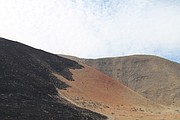Wahluke Slope Fire in mop-up stages as officials weight restoration options
EMRY DINMAN | Hagadone News Network | UPDATED 7 years, 3 months AGO
A brush fire that started Friday night burned at least 13,000 acres along the Saddle Mountain National Wildlife Refuge, torching both slopes of the National Wildlife Refuge’s mountain range.
There has been no additional fire perimeter growth since late Saturday night, and the fire is currently in the mop-up stages, according to officials with the U.S. Fish and Wildlife Service, which manages Saddle Mountain area.
As Fish and Wildlife officials and fire crews finish suppressing the fire, the next step will be surveying the damage to local ecology and considering restoration options.
The area was predominantly populated by sagebrush and native bunch grasses, and officials will need to assess whether reseeding will be necessary for slow-growing sagebrush, said Trevor Fox, refuge manager for the Hanford Reach National Monument. Native bird populations, such as sage sparrows and sage thrashes, could also be impacted by habitat loss as a result of the blaze, Fox said.
Invasive plant species also pose a challenge to wildlife managers, Fox said, and early-germinating species like cheatgrass may be monitored to ensure they can’t establish a foothold in the area before native grasses return.
Fire officials say the cause of the fire has not been determined, but is suspected to have been caused by a lightning storm. A storm system that dropped rain on some parts of western Grant County Friday night brought only dry lightning to the Saddle Mountain.
Fire crews tended to the blaze throughout the night, digging fire lines and keeping an eye out for flare-ups, according to fire officials.
A Level 1 (get ready) evacuation notice was issued for residents along state Route 26 near the border between Adams and Grant counties Saturday, but has since been canceled.
What were originally two separate fires started shortly after 11 p.m. Friday night on the south slope of the Saddle Mountains near state Route 24, milepost 59.
Each fire was initially separated by an east-west running irrigation channel but then merged, and were being treated by fire officials singularly as the Wahluke Slope Fire. The blaze then passed northward over the top of the mountains.
Strong gusts during the storm contributed to the twin blazes’ rapid growth, which had reached 11,000 acres as of this morning. Winds had died down Saturday morning but picked back up by the afternoon. Plant density and dried vegetation in the area also posed a high risk.
The mountainous area created difficulties for firefighters trying to fight the fire, according to fire officials. A fire-bomber was deployed to drop retardant on the fire with helicopter support, according to Central Washington Dispatch officials. Retardant was dumped in an ochre line along the blaze’s western edge, which helped prevent the fire from moving further toward Royal City.
ARTICLES BY EMRY DINMAN
Mattawa Police Department to use new emergency alert system
The Mattawa Police Department will be using a new emergency alert system to better and more quickly inform residents of fires, traffic hazards and other incidents.
Royal City seeking new councilmember
The Royal City Council is going to enter the new year short one councilmember, and is currently soliciting applications from individuals interested in filling the position.
Mattawa looks to the legislature to make filling agency easier
To combat the difficulties Mattawa has had filling its Civil Service Commission, the town is deploying municipal lawyer Katherine Kenison to lobby the legislature to simplify the process during the upcoming legislative session.



